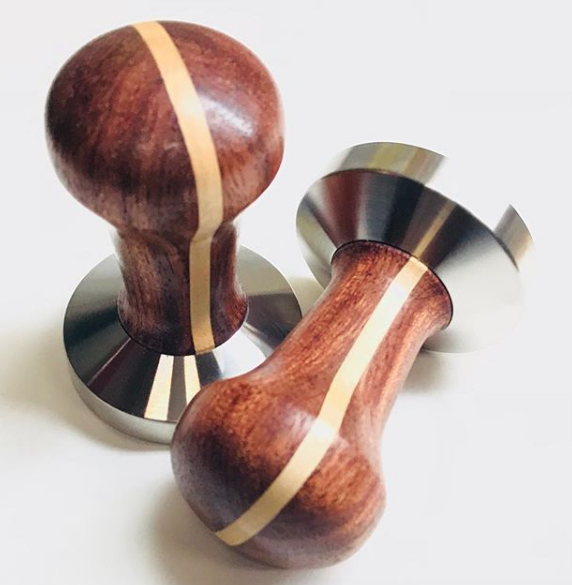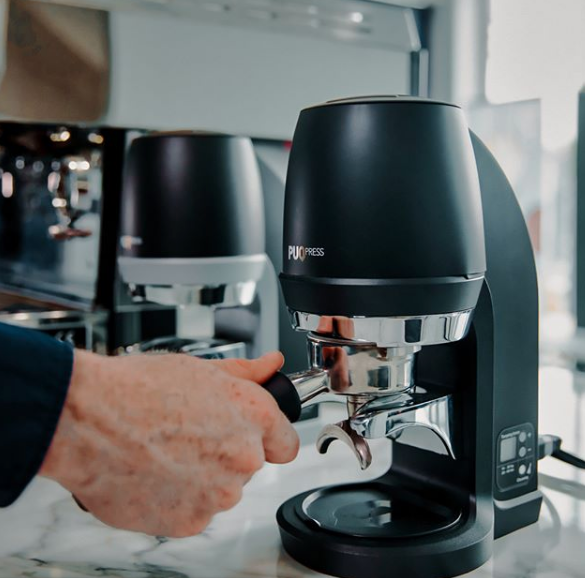Words by Michelle Johnson
When we walk into our favourite neighbourhood coffee shop, we usually notice a lot of movement going on behind the bar. We may see a barista leaned over a Chemex concentrating on the steadiness of the flow from a kettle and another fully engaged with a customer helping them choose some beans to take home. Then there’s the barista behind the espresso machine, confident and fully in control of the flow of drinks coming in and out.
A peek into their domain and you see even more movement. The barista fills the portafilter with finely ground coffee before levelling, tamping, and finally locking it into the machine to produce espresso. Of all those steps, the importance of levelling and tamping the coffee isn’t fully understood by new baristas and home coffee brewers, alike. But it’s arguably one of the most essential parts of the process — it can make or break the tastiness of your coffee!
A Brief History
In the late 90s and early 00s, tampers started to gain in popularity as baristas all over began to understand their importance in producing well-extracted coffee. Reg Barber was a pioneer in creating tampers with a wood handle and stainless steel base that fit larger espresso baskets (usually 58mm) perfectly so no coffee grind was left behind when pressing into them. Nowadays, tampers are fully customizable and come in a variety of types depending on your basket size, and even come handleless. No matter what, tampers are a staple tool on every single coffee bar across the globe, at home and in the cafe.

The Basics
What exactly is tamping and why is it so important? Tamping is just another name for compressing coffee grounds into into a “cake”, or puck, in the portafilter. But this seemingly small step carries a lot of weight.
Compressing the coffee allows the grinds to fill every space inside the portafilter so when water is finally introduced, it doesn’t flow too quickly through the puck, resulting in under-extracted espresso. But if the puck isn’t compressed enough, water flows too freely and you end up with a very watery drink. Also with the addition of pressure from the espresso machine, there needs to be some resistance from the coffee. The more resistance, the longer it takes for the water to soak through the puck, and the more extracted your beverage will be in the end. Pressure is a variable not present when brewing filter coffee [the Aeropress is arguable], but is a major factor in why the total brew time for espresso sits around 30 seconds. Most baristas equipped with only a tamper get by just fine (I did!), but a newer coffee tool has emerged in recent years—the distribution tool.
Distribution is incredibly important in espresso brewing. Have you ever seen a barista swinging their arm and fingers around a portafilter, moving the coffee about? That’s distribution (and more specifically, this method is called ‘Stockfleth’). Prior to tamping, you don’t want there to be more coffee in any one part of the portafilter. The goal is to have a flat bed so the water can do its thing at an even pace for every grind. Tamping alone achieves this to some degree, but manual distribution absolutely ensures even extraction and better tasting coffee.
Distribution tools usually look like large metal pucks with an adjustable piece at the bottom that levels the coffee without compressing it, creating a flat canvas for even tamping. These tools also aid in consistency—something manual distribution can’t always account for. For this reason, they’re an awesome training tool for new baristas, and even those who are more skilled use distribution tools everyday. At national and world level barista competitions, you’ll almost never see a competing barista without one because consistent distribution and an even tamp scores high technical points!

The ONA Distribution tool. Pic by ONA
Within the barista community, there is a lot of debate whether or not these tools actually distribute coffee evenly throughout the portafilter. Folks also ask if they do so any better than other methods like the Stockfleth or palm-tapping, lightly tapping the side of the portafilter to settle the coffee grinds.
Our team at Barista Hustle conducted some experimentation to answer these questions. We found that distribution tools didn’t perform any better than other methods, but that doesn’t mean they’re not useful. Ultimately, it comes down to personal preference and your budget.
Which Will Work Better For Me?
Between tampers and distribution tools, there are a range of options on the market to choose from for home coffee bars. Out of the two, tampers are a non-negotiable for brewing espresso. Most new home espresso machines will come with a simple, dumbell-shaped tamper. It’ll get the job done, but it never hurts to upgrade so that you can get the most out of your coffee!
First, you have to know the size of your espresso basket and purchase a tamp who’s base will fit. Any space left between the tamper and the walls of the basket will result in loose grinds. Those will have a negative effect on the taste of your coffee. Once that’s figured out, determine your price point. Wood, steel, and customizable tampers are usually priced between $50-$100 USD, depending on the customization. The PUSH Tamp, a handless tamper that helps relieve stress on the wrist (especially for baristas who work in high volume cafes), is priced at just under $200 USD. Another popular option is the Barista Hustle tamper, a minimal, black aluminium tamper ($55 USD) with a replaceable stainless steel base should it dent when dropped ($15 USD).
Some coffee shops remove manual tamping altogether and will buy a machine tamp—the Puqpress is the most well-known option. This has been really helpful for maintaining physical wellness for baristas in protecting their wrists. If you find this is important, consider investing in one!

The Puqpress, automatic tamping tool. Pic by Puqpress Official
As far as distribution tools go, it’s completely up to you. It’s a great practice to implement into home espresso brewing. More often than not, you’ll find your espresso tasting better and more consistent. Distribution tools are usually expensive, though. The OCD is priced just under $200 USD and most others are in that range. It’s possible to achieve consistency with manual methods of distribution, but with the one thing all coffee brewing requires—practice!
There are so many things that go into making the perfect cup of coffee. On top of remembering all the steps of the process, the tools needed all have their own intentional uses that are important. Now when you walk into the nearest shop, you’ll have a better understanding of what’s going into brewing that tasty espresso that keeps you coming back. Hopefully, you’ll also realize this is attainable and achievable at home, too, and you can enjoy great coffee anywhere.